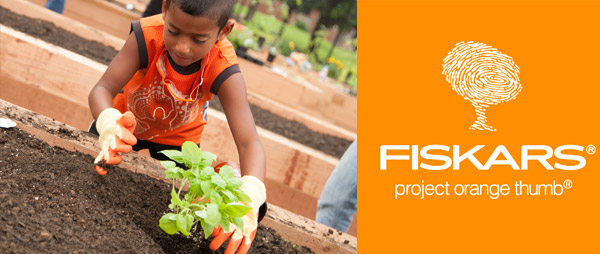
Since 2002 Fiskars Project Orange Thumb® has awarded $1.6 million in cash and tools to 180 community garden groups across the US and Canada. In 2016 the green growing initiative will continue, awarding $3500 in cash and tools to each of 30 community gardens, and like last year, I will be returning as a member of the editorial board to pour over applications and help select the winning applicants.

Project Orange Thumb® Supports:
- Urban Gardens
- Educational Gardens
- Therapeutic Gardens
Applications will be accepted until February 1, 2016 so click over here to apply and get your group in the running! The list of winning recipients will be announced on the Fiskars website March 2, 2016.
——————-
Disclosure: As mentioned above, I am on the Project Orange Thumb® editorial board for 2016, which is a paid position.
I see that you include therapeutic functions as an aspect of gardens. Increasingly, people I’ve spoken with consider spaces with wild plants that support birds, butterflies, bees and other wild animals to be relaxing and beneficial against anxiety and stress.
In order to help provide this type of relief in our world, I have designed a program to encourage people to turn their yards into wild ones, creating oases of food, water, and cover. By sharing cuttings, seeds, and information as well as creating and mapping a network of wild spots, and providing yard signs (these could be funded by Fiskars and have the Fiskars name on them,) a wonderful contribution could be made to people’s lives and to our planet. This need not be limited to therapeutic benefits. For example, early-flowering fruit trees bring a feeling of spring into the winter. The Mexican plum’s gorgeous pink flowers, appearing at an often-dreary time, then give way to fruit humans and birds can share. Some of these trees’ plums are tart, good for jams, and some deliciously sweet: more fun for seed- and cutting-exchangers who have an individual tree that bears exceptionally fine-tasting fruit. In any event, all contribute to a basic function of plants and trees: consume carbon dioxide and emit purified, cooled oxygen. We especially need these pollution-fighting wild yards in our cities and towns.
Although some wild yards can thrive with little or no human intervention, most do better by the use of trimming, nicking seeds to help them germinate, dead-heading flowers to increase their number, and taking cuttings to propagate plants to share. My question is, would this qualify for a community garden grant?
Hi — I am not involved in deciding what qualifies a garden for application so this is not a question I can answer. I’d suggest heading over to the Project Orange website to find out more http://www2.fiskars.com/Community/Project-Orange-Thumb
Sounds like a good initiative, shame we haven’t got anything like this in the UK.